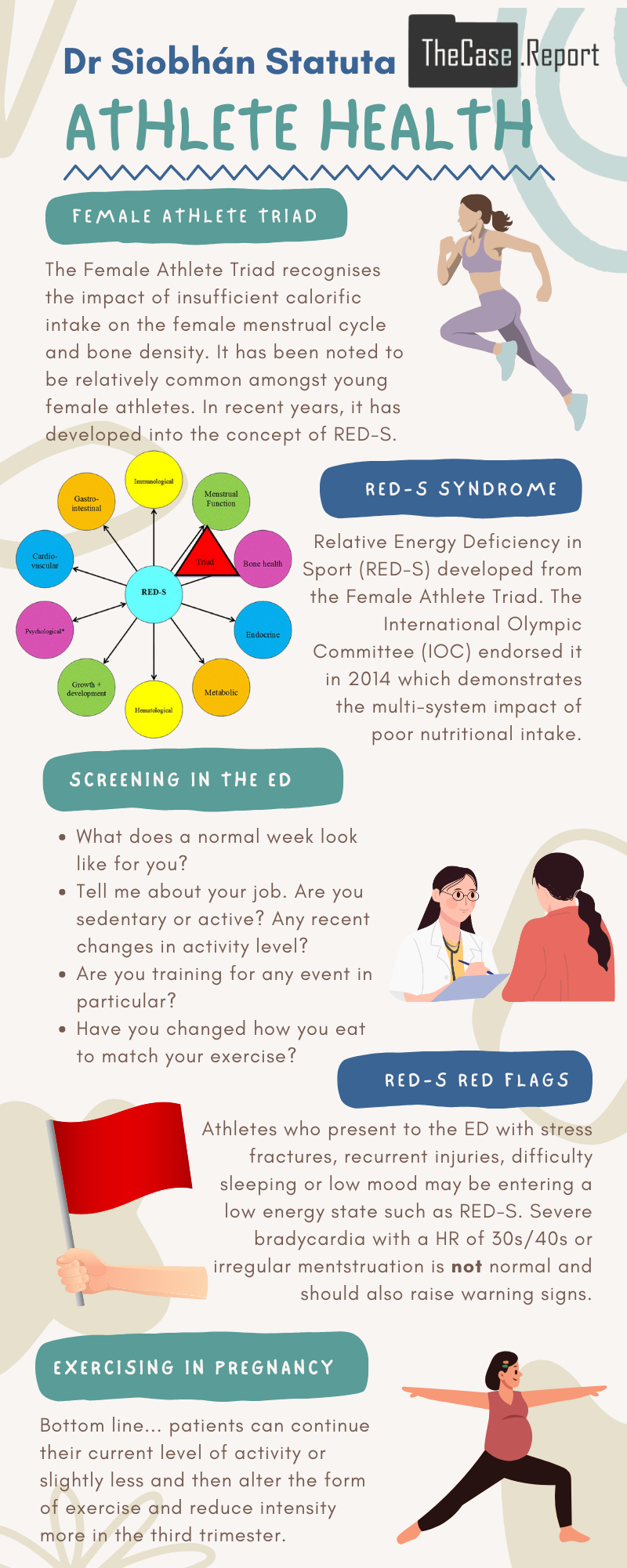S3E9: Bonus - Dr Siobhan Statuta - Sports
Carl sat down this month with Dr Siobhan Statuta, an incredible Sports Medicine Primary Care specialist based in the University of Virginia. She started her career working as a surgical technologist for an orthopaedic practice that specialises in sports injuries. She undertook her residency in Family Medicine and continued on to complete a fellowship in Sports Medicine and Faculty Development. She has multiple publications in the world of female athletic medicine and concussion.
Dr Statuta has taken time out from her work touring with the US women's development football team to join us on TheCase.Report to discuss all things RED-S and female athlete health.
Female Athlete Triad
The Female Athlete Triad was conceptualised in the late 1990s and revised in 2007. At the top of the triad is nutrition. It notes that as a result of insufficient calorific intake, there can be subsequent impact on menstruation. This leads to dysfunctional metabolism and low bone mineral density.
RED-S
RED-S is an acronym for relative energy deficiency in sport. It follows on from the Female Athlete Triad. The term was endorsed by the International Olympic Committee in 2014 and expands on the subject, recognising that the syndrome affects multiple organ systems including your cardiovascular health, metabolic health and mental health. It is also not limited to female athletes but impacts male athletes also.
Some of the first signs and symptoms in female athletes, can be seen in their menstrual cycle. This is due to a decrease in oestrogen production which causes disregulation in hormone production in females. In males, this can also impact the hypogonadal system causing issues in libido, spermatogenesis and mental health.
Screening in the ED
Red flags for RED-S
Spontaneous fractures or stress fractures in a younger person
Sudden loss in body weight or notable cachexia
Possible change in personality/ behaviour +/- menstrual cycle disregulation in a female
Severe bradycardia with HR 30s-40s is not normal
It is important to note that changes may be mild or subtle and may not initially be noticed by athletes or their family. Menstrual cycle disruption secondary to sports should not be normalised.
Get used to openly taking a nutritional and menstrual history in young females especially.
Screening questions in the Emergency Department include:
What does a normal week look like for you?
Tell me about your job. Are you sedentary or active? Has this changed recently?
Are you training for any event in particular
Some athletes will have a noticeable response to this. They may even show you recent training plans and personal bests. This can sometimes be a red flag for “overtraining” especially in the context of signs and symptoms.
What sort of food do you like eating?
Explore this a little more if possible. Especially if they are quick to tell you about their “healthy” eating habits. This can be a red flag for “orthorexia”.
Ask about vegetarianism and preferences.
RED-S prone patients can be deficient in calories especially from carbohydrates and proteins. They need a wider variety of foods in their diet.
If there is any concern for these patients, a community of in-hospital referral to a dietician or nutritionist would be useful.
Mental Health in Athletes
Mental Health screening is also important in athletes. The International Olympic Committee released some great screening tools which are referenced below. They screen for things like depression, anxiety, eating disorders, sleep disturbance and alcohol or substance dependence issues. However, they also broaden out at the end to include screening for other problems.
These tools might be slightly too comprehensive for a busy Emergency Department but some of the concepts and questions are good to use and then can be encouraged in the community setting for follow up.
The patients that we can meet in the ED are those that may have experienced an injury. In some cases, these injuries can have caused a prolonged delay in return to sport or even have forced an early retirement on high-performing athletes. Michael Phelps released a documentary in 2020 called ‘The Weight of Gold’ which we reference below. Unfortunately, it’s currently only available on HBO Max so reach out to those US connections you may have!
Exercising in Pregnancy
So the urinary HCG is positive and you’ve delivered the news to the patient. Sometimes, the Emergency Department is the place where patients ask us these questions. Patients who exercise frequently often want to know about what they can expect going forwards.
Bottom line, if you exercise frequently, you can and should be considered to at the same level or slightly less. The third trimester should change slightly. This is due to multiple changes but also changes in centre of gravity. They should alter their exercise. Dr Statuta gives the example of switching to something like an elliptical instead of running.
However, any abnormal PV bleeding, abdominal pain or cramping warrants tertiary review.
References
Sport Ireland (2023) ‘RED-s’. Available online at: https://www.sportireland.ie/institute/performance-service/nutrition/red-s
[Image 1] AlgaeCal (2020) ‘The Female Athlete Triad and Your Bones’. Available online at: https://blog.algaecal.com/female-athlete-triad/
Williams et al. (2017) ‘Female Athlete Triad: Future Directions for Energy Availability and Eating Disorder Research and Practice. Clin Sports Med 36 (2017) 671–686. Available online at: http://dx.doi.org/10.1016/j.csm.2017.05.003.
Statuta et al. (2017) ‘Relative Energy Deficiency in Sport (RED-S).’ Br J Sports Med November 2017 Vol 51 No 21. Available online at: http://dx.doi:10.1136/bjsports-2017-097700
Mountjoy et al. (2014) ‘The IOC consensus statement: beyond the Female Athlete Triad—Relative Energy Deficiency in Sport (RED-S)’. Br J Sports Med 2014;48:491–497. Available online at: https://bjsm.bmj.com/content/bjsports/48/7/491.full.pdf
IOC Mental Health Working Group (2020). ‘SMHAT-1 The International Olympic Committee Sport Mental Health Assessment Tool 1’. Available to download at: https://olympics.com/athlete365/app/uploads/2021/06/BJSM-SMHAT-1-Athlete365-2020-102411.pdf
IOC Mental Health Working Group (2020). ‘SMHRT-1 The International Olympic Committee Sport Mental Health Recognition Tool 1’. Available to download at: https://olympics.com/athlete365/app/uploads/2021/06/BJSM-SMHRT-1-Athlete365-2020-102411.pdf



